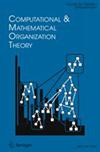Confronting Power Asymmetries in Partnerships to Address Grand Challenges
IF 1.8
4区 管理学
Q3 COMPUTER SCIENCE, INTERDISCIPLINARY APPLICATIONS
Computational and Mathematical Organization Theory
Pub Date : 2022-04-01
DOI:10.1177/26317877221098765
引用次数: 16
Abstract
Much of the literature on multistakeholder partnerships that addresses grand challenges has extolled the virtues of such partnerships as a means of reducing uncertainty, acquiring resources, and solving local and global wicked problems. These virtues include opening up “access and agendas to wider participation” (Gray, 1989, p. 120), coordinating across jurisdictional boundaries, mobilizing diverse and heterogeneous actors, and generating novel solutions to address these complex problems. Yet partnerships are not panaceas, and the reasons they fall short of their stated aspirations remain underexplored. We argue that attention to the political landscape, and particularly who has power and who does not, can account for the shortfalls of many partnerships. Theory and practice can improve by considering power dynamics in the institutional field that shapes the context in which partnerships unfold and influences the problems partnerships are designed to affect. We consider four field conditions that differ with respect to the degree of power and alignment of goals among actors in the field. We discuss four trajectories of change originating from each of these field conditions that describe shifts in field-level power or alignment of goals: collaboration, contention, consciousness raising, and compliance. We explore the dynamics associated with each trajectory to show how fields may shift toward or away from conditions conducive to building and sustaining collaborative partnerships around grand challenges.应对伙伴关系中的权力不对称以应对重大挑战
许多关于解决重大挑战的多方利益相关者伙伴关系的文献都赞扬了这种伙伴关系的优点,认为它是减少不确定性、获取资源以及解决地方和全球棘手问题的一种手段。这些优点包括开放“更广泛参与的途径和议程”(Gray, 1989,第120页),跨司法管辖区协调,动员不同和异质的行动者,并提出解决这些复杂问题的新解决方案。然而,伙伴关系并非灵丹妙药,它们未能实现其既定目标的原因仍未得到充分探讨。我们认为,对政治格局的关注,特别是对谁有权力谁没有权力的关注,可以解释许多伙伴关系的不足。理论和实践可以通过考虑制度领域的权力动态而得到改进,这种权力动态塑造了伙伴关系展开的背景,并影响了伙伴关系旨在影响的问题。我们考虑了四种不同的领域条件,这些条件与该领域参与者之间的权力程度和目标一致性有关。我们讨论了四种变化轨迹,这些变化轨迹来自于描述领域层面权力或目标一致性变化的领域条件:合作、竞争、意识提升和遵从。我们将探索与每个轨迹相关的动态,以显示领域如何朝着有利于围绕重大挑战建立和维持合作伙伴关系的条件转变或远离。
本文章由计算机程序翻译,如有差异,请以英文原文为准。
求助全文
约1分钟内获得全文
求助全文
来源期刊

Computational and Mathematical Organization Theory
COMPUTER SCIENCE, INTERDISCIPLINARY APPLICATIONS-MATHEMATICS, INTERDISCIPLINARY APPLICATIONS
CiteScore
3.80
自引率
16.70%
发文量
14
审稿时长
>12 weeks
期刊介绍:
Computational and Mathematical Organization Theory provides an international forum for interdisciplinary research that combines computation, organizations and society. The goal is to advance the state of science in formal reasoning, analysis, and system building drawing on and encouraging advances in areas at the confluence of social networks, artificial intelligence, complexity, machine learning, sociology, business, political science, economics, and operations research. The papers in this journal will lead to the development of newtheories that explain and predict the behaviour of complex adaptive systems, new computational models and technologies that are responsible to society, business, policy, and law, new methods for integrating data, computational models, analysis and visualization techniques.
Various types of papers and underlying research are welcome. Papers presenting, validating, or applying models and/or computational techniques, new algorithms, dynamic metrics for networks and complex systems and papers comparing, contrasting and docking computational models are strongly encouraged. Both applied and theoretical work is strongly encouraged. The editors encourage theoretical research on fundamental principles of social behaviour such as coordination, cooperation, evolution, and destabilization. The editors encourage applied research representing actual organizational or policy problems that can be addressed using computational tools. Work related to fundamental concepts, corporate, military or intelligence issues are welcome.
 求助内容:
求助内容: 应助结果提醒方式:
应助结果提醒方式:


